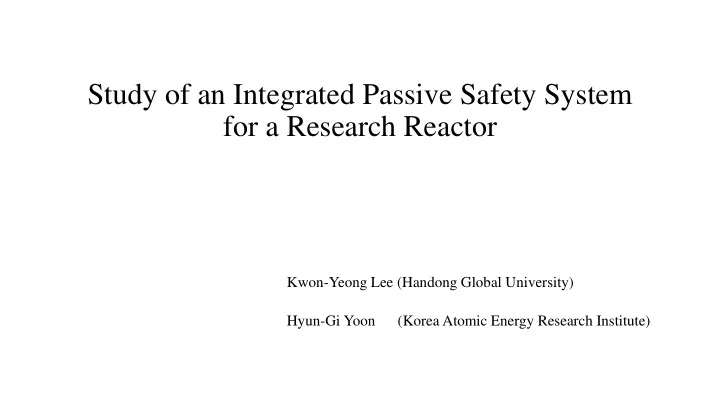

Study of an Integrated Passive Safety System for a Research Reactor Kwon-Yeong Lee (Handong Global University) Hyun-Gi Yoon (Korea Atomic Energy Research Institute)
Introduction The safety related devices in the JRTR ► The decay tank is a device that provides sufficient flow residence time to decrease the N-16 activity ► The siphon breaker is a safety device used to prevent a severe accident such as a Loss Of Coolant Accident (LOCA) Previous decay tank model Previous siphon breaker model
Introduction The new concept of an integrated passive safety facility 1) Decay tank, which reduces the radioactivity by delaying the passing time of the coolant in the normal operation 2) Siphon breaker, which prevents coolant loss when a LOCA occurs 3) Long-term cooling tank, which can remove the decay heat of the core by supplying the coolant to the reactor pool passively
Introduction Research purpose ► Simulation analysis for the design and optimization of the integrated passive safety facility in a 15- MW research reactor ► Decay tank analysis ► Siphon breaker analysis The aim of this research is to design and optimize the structure of the two devices, the decay tank and siphon breaker, based on the results of the CFD analysis
System Description A new safety system ► A new safety system for a research reactor, which integrates the decay tank, siphon breaker, and long- term cooling tank as a single facility Table. Operating conditions of integrated passive safety system Operation Normal operation LOCA accident conditions A section B section A section Involved parts + B section + Siphon breaking valve + B section + C section Functions Decay tank Siphon breaker Long-term cooling tank Schematic of integrated passive safety system
System Description Decay Tank ► The coolant that flows into Section A stays inside Section A for a sufficient flow residence time. ► After that, the coolant flows into Section B through the connection region at the bottom of Section B. ► Then, the coolant flows into Section C through the connection region at the top of Section C and exits through the main pipe of the PCS at the bottom of Section C. Operation modes of integrated passive safety system(decay tank)
System Description Siphon Breaker ► At the top of Section B, the air pours in by opening the siphon breaking shut-off valves when siphoning occurs ► The air fills Section B up to the connection region at the top and stops the siphon phenomenon by shutting the coolant flow off Operation modes of integrated passive safety system(decay tank)
System Description Long-term Cooling Tank ► Sections A and B then act as the long-term cooling tank and compensate for the evaporated water in the reactor pool Operation modes of integrated passive safety system(decay tank)
CFD Analysis Decay Tank ► Tetrahedron-shaped and hexahedron-shaped are used ► The number of meshes was 300,000 ► k –ε model and transition shear stress transport (SST) model are used ► Automatic wall treatment model was used ► The DPM function is used for the particle tracking method Decay tank model Mesh modeling of decay tank ► A minimum of 60 s of flow residence time is given as the design requirement for the decay tank
CFD Analysis Siphon Breaker ► The mesh size of the reactor pool is relatively coarse ► Fine mesh is used at the regions that include the siphon breaker and the connection ► An 18-inch siphon breaking valve is used ► The volume of fluid model is used ► The realizable k –ε model is used ► The transient calculation method is used ► A time step of 0.01 – 0.05 Mesh modeling for siphon breaker evaluation
Results and Discussion Analysis Results of Decay Tank ► By installing a triangular barrier between the second and third sections, the flow residence time became longer than 60 s for the conservative design Table. decay tank models and CFD results Width (m) Length (m) Height (m) Section numbers Mass flow rate (kg/s) Flow residence time (s) 1.5 2 8 4 600 67 Velocity profiles of decay tank models Streamline of fastest particles for decay tank model
Results and Discussion Analysis Results of Decay Tank ► It has been confirmed that the residence time of all particles exceeds 60 s ► The residence time of 70% of the particles stays within 60 to 100 s Particle distribution for decay tank model
Results and Discussion Analysis Results of Siphon Breaker ► It will take approximately 220 s for the water in the reactor pool to be completely exhausted ► The decay tank is disconnected between the third and fourth sections because of the siphon breaking ► The siphon phenomenon is broken in approximately 5 s Simulation result of siphon phenomenon Simulation result of siphon breaking phenomenon
Conclusions ► The effectivity of an innovative integrated passive safety system for a research reactor is verified using CFD ► Using the DPM function, it was found that the flow residence time in decay tank is at least 67 s to satisfy minimum residence time of 60 s ► The siphon phenomenon can be stopped by installing a siphon breaker in the third section of the decay tank ► This new integrated safety system provides the three functions of a decay tank, siphon breaker, and long-term cooling tank respectively ► Therefore, the available space can be efficiently used with a single structure
Recommend
More recommend